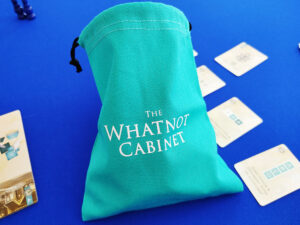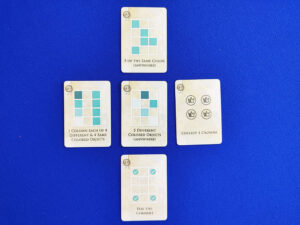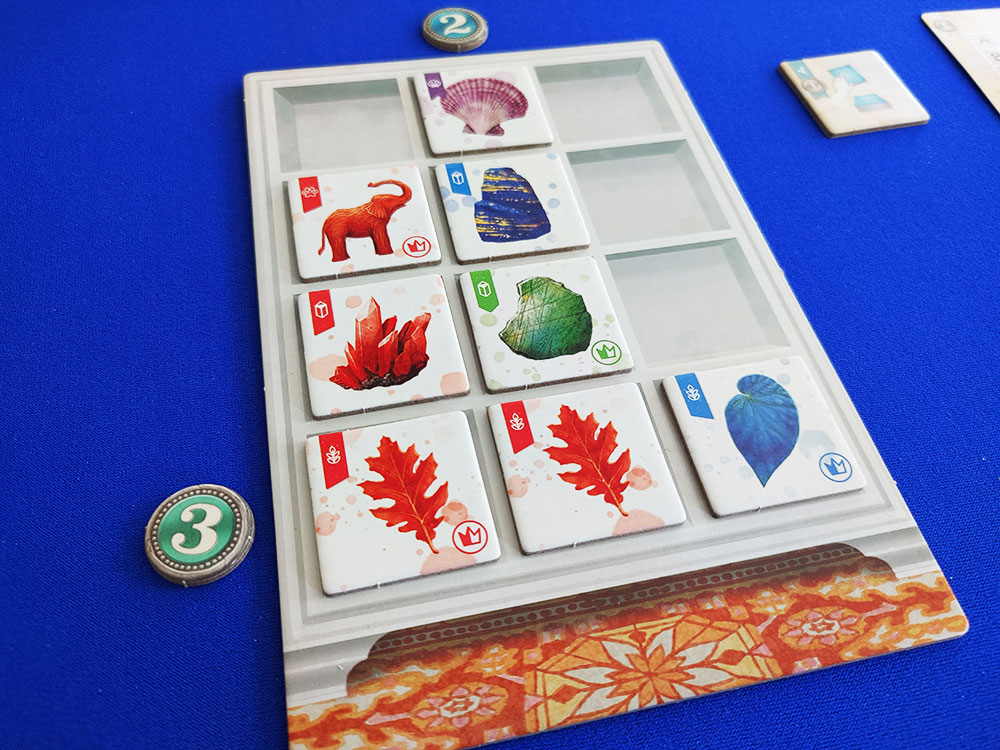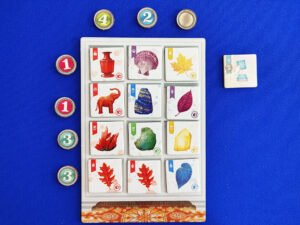 As Board Game Quest’s resident movie person, I always get handed games that fall between the worlds of cinema and gaming. When our benevolent leader Tony Mastrangeli told me there was a new game based on the classic horror film The Cabinet of Dr. Caligari, it was a no-brainer that I should be the one to cover it.
As Board Game Quest’s resident movie person, I always get handed games that fall between the worlds of cinema and gaming. When our benevolent leader Tony Mastrangeli told me there was a new game based on the classic horror film The Cabinet of Dr. Caligari, it was a no-brainer that I should be the one to cover it.
I was curious how the designers would implement the silent film’s abstract visual style and how they’d approach the reality-bending narrative of the movie.
When The Cabinet of Dr. Caligari: The Game finally arrived, I realized that—once again—Publisher Mastrangeli had been completely dishonest with me. The game is actually called The Whatnot Cabinet and has nothing to do with the century-old German film. It’s designed by Steve Finn and instead of featuring the horrific imagery from the movie, it has colorfully serene artwork by Beth Sobel.
I was shaken by the sudden change of theme, but my resolve to play the game and complete the review was undeterred. That’s the level of dedication you can expect from the folks here at Board Game Quest.
Gameplay Overview:
The Whatnot Cabinet is a drafting, tile placement game with a set collection flare. At the start of each turn, four object tiles will be drawn from a bag and placed in front of all players. This common area is called the Outdoors (theme!). Beginning with the player in the first space of the Landscape section (that’s the turn order track), players will be drafting two tiles using one of the five action types.

The actions are divided into columns and work in the following ways:
- Column 1 – Draw three random tiles, keep two, discard one.
- Column 2 – Draw two tiles, keep one, and add the other to the Outdoors before taking another tile.
- Column 3 – Add a single tile from the bag to the Outdoors and then take two from there.
- Column 4 – Add two tiles from the bag to the Outdoors and then take two from there.
- Column 5 – Discard all tiles from the Outdoors, add four tiles from the bag to the Outdoors, and then take two from there.
To select an action, a player will move their pawn from the Landscape row onto the specific action space and then place their tiles into their three-square by four-square cabinet using that action. Once players place a tile it cannot be moved. There are five colors and five object types mixed in the draw bag.
After everyone has selected their action and tiles for the round, the position of everyone’s pawns dictates turn order for the next round. Selecting the more powerful actions means players will select their objects later in the following round.

As players fill their cabinets, they will be completing rows and columns, which score in different ways. Completing a column with four of the same-colored objects scores four points at the end of the game. Having four different colored objects in a column will score you two points and any other configuration won’t score at all. Similarly, completed rows with three of the same object type will score players three points, three different object types will score one point, and any other mix won’t score.
During every game, there will be five Curiosity cards players can claim that require specific criteria. These vary but include concepts such as having four objects of the same type anywhere in the cabinet or completing a certain row and column configuration. The first player to achieve the goal on the card will earn those points at the end of the game. There is also a single Wonder card in play every game that all players will score. This Wonder card targets a specific object type and rewards players for having a lot of that type in their cabinet.
Play continues in this fashion for six rounds at which point players will add up the points from the rows and columns of their cabinet, as well any bonus points they accumulated from Curiosity and Wonder cards. Whomever has the most points wins the game because they have the best cabinet. (I think? I’m not entirely sure what players are competing over. Maybe a cabinet contest of some kind? Is that a thing?)

Game Experience:
Pencil First Games makes games that all have a similar flavor and style and The Whatnot Cabinet is no different. Going into the game, players probably know what to expect in terms of weight and the pace of gameplay. Still, the game does do some interesting things despite the relative simplicity of the design.
The tile drafting might seem obvious at first glance (“I want this color to complete that row” and so on), but it’s complicated by the ways in which you can select your two tiles. Selecting one of the more randomized tile-selection actions might not give a player the tile they’d prefer, but it does set them up to pick first in the next round. This could be key to completing one or more of the Curiosity cards, since only one person can claim those points.

This “go first vs. choose first” mechanism is similar to how you pick tiles in Kingdomino and is a fun way to balance out turn order over the course of the game. It’s also interesting that the three weakest actions will give players points if they choose them in the final round. I’m not sure that aspect is perfectly balanced because getting three quick points right at the end is a pretty big swing, but at the very least it’s a unique idea.
The fact that each row and column will only score once makes early tile placement important. Players can jump around the board to set themselves up, but often it’s most advantageous to focus on the Curiosity and Wonder cards and hope you don’t ruin your chances at higher scoring rows and columns in the process.
One area of the game that doesn’t feel strong is its long-term replay value. It does include 12 Curiosity cards and five Wonder cards that get shuffled before every play, but these don’t drastically alter the flavor of the game. Every game has the same flow with just a few minor tweaks to what objects players may want to seek out.
Final Thoughts:

The Whatnot Cabinet is a solid drafting game that knows what it wants to be and sticks very closely to that. There won’t be a lot of surprises from game to game and it’s best played as a quick filler to offset heavier stuff or with casual gamers.
(The name alone is probably enough to rope in a few non-gamers. Incidentally, my wife couldn’t shake the notion that the game was somehow tied to The Little Mermaid and that we were actually playing as different versions of Ariel filling up her supply of random stuff from the human world. Perhaps a better title for this game would have been The Whozits and Whatzits Cabinet.)
The game’s most appealing concept is how players select their actions and the way in which it’s tied to turn order in the next round. This isn’t necessarily innovative, but it is an extra layer of depth that complicates the decision-making process slightly. Still, with so few turns and such a quick turnaround of available tiles, turn order doesn’t always feel as important in this game as it is in others.
Aside from that minor issue with the action selection, The Whatnot Cabinet’s biggest flaw is its replay value. There are a decent number of ways to change the scoring from game to game, but none of it feels particularly different. (The game also includes a solo mode, but it’s a fairly unengaging “high score” exercise.) After every play, I commented that I enjoyed the experience and yet didn’t have much desire to play again.
Final Score: 3 Stars – A light, pleasant game that is fun in small doses, but lacks enough play variety to make it stand out.
 Hits:
Hits:
• Interesting action selection system
• Easy to learn
• Quick playing time
Misses:
• Every game essentially plays the same way
• Lack of variety in setup
• Solo mode is uninteresting





















